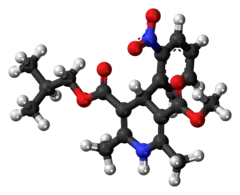Nisoldipine
 | |
 | |
| Names | |
|---|---|
| Pronunciation | nye sol' di peen[1] |
| Trade names | Sular, Baymycard, Syscor, others |
IUPAC name
| |
| Clinical data | |
| Drug class | Calcium channel blocker (dihydropyridine)[2] |
| Main uses | High blood pressure[2] |
| Side effects | Swelling, headache, palpitations, nausea, rash[2] |
| WHO AWaRe | UnlinkedWikibase error: ⧼unlinkedwikibase-error-statements-entity-not-set⧽ |
| Pregnancy category |
|
| Routes of use | By mouth |
| External links | |
| AHFS/Drugs.com | Monograph |
| MedlinePlus | a696009 |
| Legal | |
| Legal status |
|
| Pharmacokinetics | |
| Bioavailability | 4–8% |
| Protein binding | >99% |
| Metabolism | CYP3A4 |
| Elimination half-life | 7–12 hours |
| Excretion | 70–80% via urine |
| Chemical and physical data | |
| Formula | C20H24N2O6 |
| Molar mass | 388.414 g·mol−1 |
| 3D model (JSmol) | |
SMILES
| |
InChI
| |
Nisoldipine, sold under the brand name Sular, is a medication used to treat high blood pressure.[2] It may be used by itself or with other medications.[2] It is taken by mouth.[2]
Common side effects include swelling, headache, palpitations, nausea, and rash.[2] Other side effects may include angina, low blood pressure], and allergic reactions.[2] While use during pregnancy is not well studied, risk is low.[3] It is a calcium channel blocker (CCB) of the dihydropyridine class.[2] It works by resulting in vasodilation of arteries.[1]
Nisoldipine was patented in 1975 and approved for medical use in 1990.[4] It was approved in the United States in 1995.[2] It is available as a generic medication.[1] In the United States it costs about 54 USD per month.[5]
Medical use
Dosage
It is often started at 17 mg per day and may be increased to 34 mg per day.[2]
Contraindications
Nisoldipine is contraindicated in people with cardiogenic shock, unstable angina, myocardial infarction, and during pregnancy and lactation.[6]
Side effects
Common side effects are headache, confusion, fast heartbeat, and edema. Hypersensitivity reactions are rare and include angioedema.[6]
Interactions
The substance is metabolized by the liver enzyme CYP3A4. Consequently, CYP3A4 inducers such as rifampicin or carbamazepine could reduce the effectiveness of nisoldipine, while CYP3A4 inhibitors such as ketoconazole increase the amount of nisoldipine in the body more than 20-fold. Grapefruit juice also increases nisoldipine concentrations by inhibiting CYP3A4.[6]
Pharmacology
Mechanism of action
Nisoldipine is a calcium channel blocker that selectively inhibits L-type calcium channels.[6] It has tropism for cardiac blood vessels.[7]
It is a second generation CCB.[1]
References
- 1 2 3 4 "Nisoldipine". LiverTox: Clinical and Research Information on Drug-Induced Liver Injury. National Institute of Diabetes and Digestive and Kidney Diseases. 2012. Archived from the original on 13 November 2021. Retrieved 13 November 2021.
- 1 2 3 4 5 6 7 8 9 10 11 "Nisoldipine Monograph for Professionals". Drugs.com. Archived from the original on 21 September 2021. Retrieved 13 November 2021.
- ↑ "Nisoldipine (Sular) Use During Pregnancy". Drugs.com. Archived from the original on 22 September 2021. Retrieved 13 November 2021.
- ↑ Fischer, Jnos; Ganellin, C. Robin (2006). Analogue-based Drug Discovery. John Wiley & Sons. p. 464. ISBN 9783527607495. Archived from the original on 2021-08-29. Retrieved 2020-12-04.
- ↑ "Nisoldipine Prices, Coupons & Savings Tips - GoodRx". GoodRx. Retrieved 13 November 2021.
- 1 2 3 4 Haberfeld, H, ed. (2019). Austria-Codex (in Deutsch). Vienna: Österreichischer Apothekerverlag. Syscor 5 mg-Filmtabletten.
- ↑ Knorr, Andreas M. (1995). "Why is nisoldipine a specific agent in ischemic left ventricular dysfunction?". The American Journal of Cardiology. 75 (13): E36–E40. doi:10.1016/S0002-9149(99)80446-9. PMID 7726122.
External links
- Diseases Database (DDB): 30009
- Mielcarek J, Grobelny P, Szamburska O (2005). "The effect of beta-carotene on the photostability of nisoldipine". Methods Find Exp Clin Pharmacol. 27 (3): 167–71. doi:10.1358/mf.2005.27.3.890873. PMID 15834448.
- Missan S, Zhabyeyev P, Dyachok O, Jones SE, McDonald TF (November 2003). "Block of cardiac delayed-rectifier and inward-rectifier K+ currents by nisoldipine". Br. J. Pharmacol. 140 (5): 863–70. doi:10.1038/sj.bjp.0705518. PMC 1574108. PMID 14530219.
- Hamilton S, Houle L, Thadani U (1999). "Rapid-release and coat-core formulations of nisoldipine in treatment of hypertension, angina, and heart failure". Heart Dis. 1 (5): 279–88. PMID 11720635.
| Identifiers: |
|---|